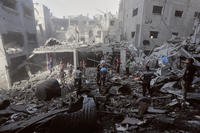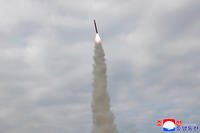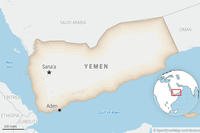Read the original article on Business Insider.
A remote US special-operations base in the Syrian desert is caught in a shadow war between military powers in the Middle East.
Al-Tanf garrison, a US base typically housing between 100 and 200 US troops alongside coalition forces, has for years been a hub for operations against ISIS as well as Iran and its proxies. In August and September, the outpost was involved in a series of attacks, including a rocket attack by Iranian-backed militias that wounded three US troops.
The base was established in 2016, when US forces were in the thick of combat operations against ISIS in Syria. US and coalition troops needed a stronghold from which they could isolate ISIS fighters and monitor activities across the region.
Al-Tanf -- in southeastern Syria along the M2 Baghdad-Damascus highway and near the borders with Iraq and Jordan -- was the ideal location.
The area around the base was liberated from ISIS that year. Shortly thereafter, the US and Russia, which were both operating in the area, agreed to set up a 34-mile deconfliction zone around the outpost.
The garrison has been a launchpad for counterterrorism and anti-smuggling operations as well as for provision of humanitarian aid and coalition-led training efforts. Sustaining a foothold at al-Tanf also helps ensure that the US is a part of discussions regarding Syria's future.
In recent months, however, al-Tanf has become a focal point in a shadowy conflict between the region's key players: Israel, the US, Russia, and Iran.
Israel regularly strikes Iranian-backed forces in Syria, and flying over al-Tanf allows Israeli aircraft to limit their exposure to Syrian air defenses, most of which are in western Syria.
Routes near al-Tanf are especially appealing for Israeli strikes against Iranian proxy forces near the al-Qaim border crossing with Iraq.
Current and former US defense officials told The Wall Street Journal in mid-June that the US had for years been reviewing Israeli plans for strikes against Iranian proxies and allies in the area to avoid interference with US-led operations against ISIS, especially those at al-Tanf.
"They like to use our air corridors because [Syria's] air defenses can't tell the difference until it's too late," a former defense official told Al Monitor later that month.
But allowing Israel and occasionally Jordan to operate around al-Tanf has exposed the US to retaliatory attacks from Iran and its proxies.
The base was hit by what was believed to be an Iranian-launched drone strike on August 15, one day after Israel struck military targets in the Syrian provinces of Damascus and Tartus -- strikes aimed at a Syrian air-defense base that often houses Iranian-backed fighters, according to the Syrian Observatory for Human Rights, a UK-based monitoring group.
The August 15 strike, which caused minimal damage and no casualties, prompted the US to retaliate with an airstrike on August 25, which in turn set off a series of attacks by US and Iranian-backed forces.
Changing Dynamics
Russia's war in Ukraine may create new problems for US troops at al-Tanf.
Grant Rumley, a US Defense Department advisor for Middle East policy during the Trump and Biden administrations, told Insider that there are additional threats around al-Tanf that now need to be considered.
One involves continuing the fight against ISIS by maintaining a physical presence and weeding the group's fighters out of local villages.
The base's role in the Syrian conflict and in the region's wider tensions may also become even more convoluted. US and Russian forces conduct patrols in northeastern Syria, where they have had both contentious and friendly interactions, but Russia's attitude may change because of events in Ukraine.
"There is the risk that Russia, on the ground in Syria, will be worried about the perception that it's focused solely on Ukraine," Rumley said. "In that regard, you could see more erratic Russian behavior, and they could not observe the 55 km [deconfliction] zone or there could be more friction at checkpoints."
Iran is also increasing its weapons shipments to Russia, sending hundreds of drones and missiles that Moscow is using in Ukraine, which may affect Tehran's actions in the Middle East.
In exchange for those weapons, Iran may ask Russia to put pressure on Israel to decrease or halt its strikes or to facilitate an increased Iranian presence on the ground in Syria, said Rumley, now a fellow at The Washington Institute focusing on great-power competition in the Middle East.
Russia has withdrawn combat forces from Syria in recent weeks, which may signal a shift in Moscow's role there, but it's unclear what that or other changes could mean for the US mission in Syria and for al-Tanf, Rumley said.
"The dynamics in Syria will change as Russia continues to get overburdened with Ukraine," Rumley told Insider. "So what might not have been possible in the past, like some sort of negotiated outcome, could become possible in the future," he added, "or it might not."
Rachel Nostrant is a US-based journalist with work published in New York magazine, VTDigger, Military Times, and Defense News. She has covered topics including environmental contamination outside of military bases, the murder of US Army soldier Vanessa Guillen, rising tensions between China and Taiwan, and the war in Ukraine.













